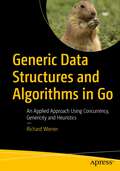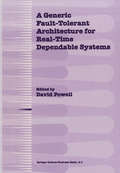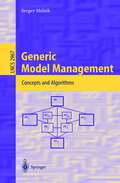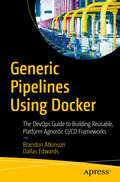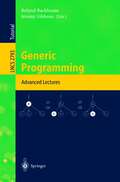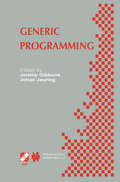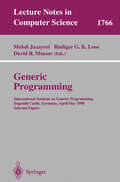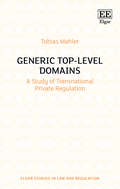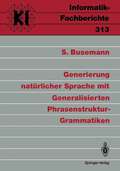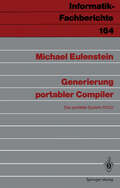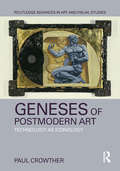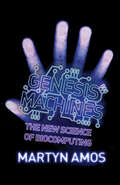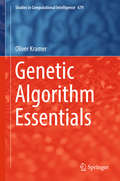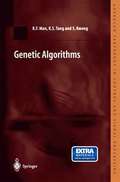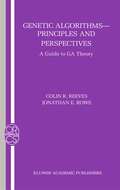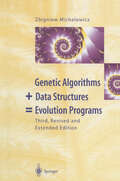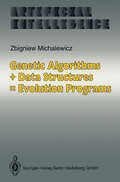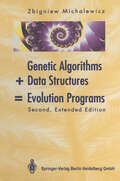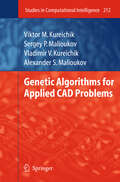- Table View
- List View
Generic Data Structures and Algorithms in Go: An Applied Approach Using Concurrency, Genericity and Heuristics
by Richard WienerAdvance your understanding of generic data structures and algorithms and their applications using Go and the effective use of concurrency. You are invited on a journey that aims to improve your programming and problem-solving skills. This book takes you to the next step by showing how to get your programs to work efficiently as well as correctly. As you explore many data structures and the algorithms and applications associated with them, you'll focus on the trade-offs between speed and storage and the benefits of deploying concurrency when appropriate. This book will demonstrate the huge increases in application performance that are possible. The presentation of classic data structures and techniques of algorithm design (greedy, divide and conquer, branch-and-bound to name a few) provides an essential foundation and toolkit for problem solving. But this book goes further by presenting heuristic algorithms and their implementations for solving computationally intractable combinatoric optimization problems such as the travelling salesperson problem. Simulated annealing and genetic algorithms are among the techniques used.The consistent style of coding used throughout this book exploits Go’s ability to implement abstract, generic and constrained generic data types without the use of classes. Although some familiarity with Go is assumed, this book should advance your ability to use Go to tackle server-side applications, games, machine learning, information retrieval and other application domains where speed and storage efficiency is essential.What You'll LearnExplore classical data structures and algorithms aimed at making your applications run faster or require less storageUse the new generic features of Go to build reusable data structuresUtilize concurrency for maximizing application performanceSee the power of heuristic algorithms for computationally intractable problemsEnhance and improve your Go programming skillsWho This Book Is ForPracticing Go software developers and students who wish to advance their programming and problem-solving skills and experience the excitement and see the benefits of using generic data structures and algorithms that utilize concurrency whenever possible.
A Generic Fault-Tolerant Architecture for Real-Time Dependable Systems
by David PowellThe design of computer systems to be embedded in critical real-time applications is a complex task. Such systems must not only guarantee to meet hard real-time deadlines imposed by their physical environment, they must guarantee to do so dependably, despite both physical faults (in hardware) and design faults (in hardware or software). A fault-tolerance approach is mandatory for these guarantees to be commensurate with the safety and reliability requirements of many life- and mission-critical applications. This book explains the motivations and the results of a collaborative project', whose objective was to significantly decrease the lifecycle costs of such fault tolerant systems. The end-user companies participating in this project already deploy fault-tolerant systems in critical railway, space and nuclear-propulsion applications. However, these are proprietary systems whose architectures have been tailored to meet domain-specific requirements. This has led to very costly, inflexible, and often hardware-intensive solutions that, by the time they are developed, validated and certified for use in the field, can already be out-of-date in terms of their underlying hardware and software technology.
Generic Model Management: Concepts and Algorithms (Lecture Notes in Computer Science #2967)
by Sergey MelnikMany challenging problems in information systems engineering involve the manipulation of complex metadata artifacts or models, such as database schema, interface specifications, or object diagrams, and mappings between models. Applications solving metadata manipulation problems are complex and hard to build. The goal of generic model management is to reduce the amount of programming needed to solve such problems by providing a database infrastructure in which a set of high-level algebraic operators are applied to models and mappings as a whole rather than to their individual building blocks. This book presents a systematic study of the concepts and algorithms for generic model management. The first prototype of a generic model management system is described, the algebraic operators are introduced and analyzed, and novel algorithms for implementing them are developed. Using the prototype system and the operators presented, solutions are developed for several practically relevant problems, such as change propagation and reintegration.
Generic Pipelines Using Docker: The DevOps Guide to Building Reusable, Platform Agnostic CI/CD Frameworks
by Brandon Atkinson Dallas EdwardsCreate generic pipelines to reduce your overall DevOps workload and allow your team to deliver faster. This book helps you get up to speed on the pros and cons of generic pipeline methodology, and learn to combine shell scripts and Docker to build generic pipelines.In today’s world of micro-services and agile practices, DevOps teams need to move as fast as feature teams. This can be extremely challenging if you’re creating multiple pipelines per application or tech stack. What if your feature teams could utilize a generic pipeline that could build, test, and deploy any application, regardless of tech stack? What if that pipeline was also cloud and platform agnostic? Too good to be true? Well think again! Generic Pipelines Using Docker explores the principles and implementations that allow you to do just that. You will learn from real-world examples and reusable code. After reading this book you will have the knowledge to build generic pipelines that any team can use. What You'll Learn Explore the pros and cons of generic pipeline methodologyCombine shell scripts and Docker to build a generic pipelineImplement a pipeline across CI/CD platformsBuild a pipeline that lends itself well to both centralized and federated DevOps teamsConstruct a modular pipeline with components that can be added, removed, or replaced as needed Who This Book Is ForProfessionals who use DevOps or are part of a DevOps team, and are seeking ways to streamline their pipelines and drive more deployments while using less code
Generic Programming: Advanced Lectures (Lecture Notes in Computer Science #2793)
by Roland Backhouse Jeremy GibbonsGeneric programming attempts to make programming more efficient by making it more general. This book is devoted to a novel form of genericity in programs, based on parameterizing programs by the structure of the data they manipulate. The book presents the following four revised and extended chapters first given as lectures at the Generic Programming Summer School held at the University of Oxford, UK in August 2002: - Generic Haskell: Practice and Theory - Generic Haskell: Applications - Generic Properties of Datatypes - Basic Category Theory for Models of Syntax
Generic Programming: IFIP TC2 / WG2.1 Working Conference Programming July 11–12, 2002, Dagstuhl, Germany (IFIP Advances in Information and Communication Technology #115)
by Jeremy Gibbons Johan JeuringGeneric programming is about making programs more adaptable by making them more general. Generic programs often embody non-traditional kinds of polymorphism; ordinary programs are obtained from them by suitably instantiating their parameters. In contrast with normal programs, the parameters of a generic program are often quite rich in structure; for example, they may be other programs, types or type constructors, class hierarchies, or even programming paradigms. Generic programming techniques have always been of interest, both to practitioners and to theoreticians, but only recently have generic programming techniques become a specific focus of research in the functional and object-oriented programming language communities. Generic Programming comprises the edited proceedings of the Working Conference on Generic Programming, which was sponsored by the International Federation for Information Processing (IFIP) and held in Dagstuhl, Germany in July 2002. With contributions from leading researchers around the world, this volume captures the state of the art in this important emerging area.
Generic Programming: International Seminar on Generic Programming Dagstuhl Castle, Germany, April 27 - May 1, 1998, Selected Papers (Lecture Notes in Computer Science #1766)
by Mehdi Jazayeri Rüdiger G. K. Loos David R. MusserGeneric Top-Level Domains: A Study of Transnational Private Regulation (Elgar Studies in Law and Regulation)
by Tobias MahlerThis topical book critically examines the regulatory framework for generic Top-Level Domains (gTLDs) on the Internet. The regulation drawn up by the Internet Corporation for Assigned Names and Numbers (ICANN) applies at a global level, complementing national and international law. These rules form part of a growing body of transnational private regulation. Generic Top-Level Domains offers a clear and engaging analysis of how ICANN has tackled a diverse set of regulatory issues related to the introduction of new gTLDs, such as property rights, competition and consumer protection. Studying recent case law, the book argues for a stronger focus on procedural fairness for future introductions of new gTLDs. It also highlights how ICANN’s contractual framework regulates the registration and use of domain names and argues that ICANN’s regulatory authority ought to be clarified in order to avoid regulatory overreach. Uniquely comprehensive, this book will appeal to students and scholars with an interest in Internet governance, domain name law and transnational private regulation. Practitioners working in the domain name industry will also find this a valuable resource.
Generierung natürlicher Sprache mit Generalisierten Phrasenstruktur-Grammatiken (Informatik-Fachberichte #313)
by Stephan BusemannLinguistische Theorien bilden eine unverzichtbare Grundlage für die Verarbeitung natürlicher Sprache, will man flexible und vielseitig einsetzbare natürlichsprachliche Systeme entwickeln. Aus informatischer Sicht erscheinen sehr viele linguistische Formalismen zunächst nicht verwendbar, weil sie nicht effizient implementiert werden können. Am Beispiel der linguistischen Syntaxtheorie der Generalisierten Phrasenstruktur-Grammatik (GPSG) und des Problems der automatischen Generierung geschriebener natürlicher Sprache zeigt dieses Buch, wie die Brücke zwischen informatischen und linguistischen Ansprüchen geschlagen werden kann, so daß eine nutzbringende Symbiose entsteht.
Generierung portabler Compiler: Das portable System POCO (Informatik-Fachberichte #164)
by Michael EulensteinDas vorliegende Buch, das aus der Saarbrücker Dissertation des Verfassers entstanden ist, beschreibt ein konkretes System zur automatischen Generierung von Compilern. Das System ist für die Anwendung in der Praxis konzipiert. Es werden die Entwurfskriterien, die zu dem System geführt haben, und die vollständige Realisierung des Generators dargestellt. Aus der Struktur und der Funktionsweise von Compilern werden die Komponenten eines Compiler-Generators abgeleitet. Die Generierungsverfahren und die zugrundeliegenden theoretischen Konzepte werden vorgestellt. Die Spezifikation einer Programmiersprache (als Eingabe in den Generator) und die vom Generator erzeugte Ausgabe (ein lauffähiger Compiler) werden detailliert erläutert. Es werden Ergebnisse präsentiert, die durch praktische Anwendung des Systems erhalten wurden. Schwerpunkt des Buches ist die Generierung portabler Compiler. Dieses Ziel ist ein Entwurfskriterium für das System und wird durch die direkte Generierung von Compiler-Komponenten in Zwischensprachform erreicht. Als Zwischensprache wurde aus mehreren Kandidaten p-Code gewählt. Es wird gezeigt, daß die direkte Generierung eines Compilers eine Reihe von Optimierungen zuläßt; sie lassen sich aus Informationen ableiten, die auf Generatorebene zur Verfügung stehen. Diese Optimierungen bewirken sowohl Laufzeit- als auch Speicherplatzreduktionen im generierten Compiler.
Generierung von qualifizierten E-Mail-Adressen: 111 Taktiken für mehr Erfolg im E-Mail-Marketing
by Frank Strzyzewski Charlotte Karpa-TovarE-Mail-Marketing: Lernen Sie in diesem Buch mehr über Lead-Generierung Newsletter und E-Mail-Marketing zählen zu den ältesten Instrumenten in der Onlinewelt und sind fester Bestandteil diverser Marketing-Strategien. Dieses Buch richtet sich an Laien und Profis und zeigt ihnen, dass der Erfolg beim Aufbau eines großen und responsestarken E-Mail-Adressbestandes kein Zufall ist. Die imponierende Sammlung kreativer Ideen widmet sich den Grundlagen und Teilaspekten einer effektiven Adressgewinnung. Zudem zeigt Ihnen das Buch, wie Sie durch die Optimierung Ihres Verteilers Ihr E-Mail-Marketing deutlich verbessern.Erfahren Sie mehr über bislang wenig beachtete Taktiken und neue E-Mail-Marketing-TrendsDieses Buch befasst sich mit der Tatsache, dass die Kerngeschäfte vieler Unternehmen aus Daten bestehen. Besonders häufig finden E-Mail-Adressen Verwendung – nicht nur im Marketing, sondern ebenfalls im Vertrieb, in der Logistik und bei der Kundenbindung. Ein erfolgreiches E-Mail-Marketing-System ist somit von großer wirtschaftlicher Bedeutung. Die zweite Auflage dieses Werks beinhaltet nicht nur 40 neue Abbildungen zum E-Mail-Marketing-Aufbau und zur E-Mail-Marketing-Automatisierung, sondern widmet sich auch brandaktuellen Themen wie der 2018 in Kraft getretenen EU-DSGVO und deren Auswirkung auf die Arbeit von Online-Marketern. Zudem erhalten Leser Informationen über neue Möglichkeiten und Taktiken, E-Mail-Adressen erfolgreich zu generieren – beispielsweise durch Blockchain, Spracheinwilligung, Twitter oder andere Social-Media-Kanäle.
Generierung von Worthypothesen in kontinuierlicher Sprache (Informatik-Fachberichte #141)
by Ernst G. Schukat-TalamazziniGeneses of Postmodern Art: Technology As Iconology (Routledge Advances in Art and Visual Studies)
by Paul CrowtherPostmodernism in the visual arts is not just another 'ism.' It emerged in the 1960s as a transformation of artistic creativity inspired by Duchamp's idea that the artwork does not have to be physically made by its creator. Products of mass culture and technology can be used just as well as traditional media. This idea became influential because of a widespread naturalization of technology - where technology becomes something lived in as well as used. Postmodern art embodies this attitude. To explain why, Paul Crowther investigates topics such as eclecticism, the sublime, deconstruction in art and philosophy, and Paolozzi's Wittgenstein-inspired works.
Geneses of Postmodern Art: Technology As Iconology (Routledge Advances in Art and Visual Studies)
by Paul CrowtherPostmodernism in the visual arts is not just another 'ism.' It emerged in the 1960s as a transformation of artistic creativity inspired by Duchamp's idea that the artwork does not have to be physically made by its creator. Products of mass culture and technology can be used just as well as traditional media. This idea became influential because of a widespread naturalization of technology - where technology becomes something lived in as well as used. Postmodern art embodies this attitude. To explain why, Paul Crowther investigates topics such as eclecticism, the sublime, deconstruction in art and philosophy, and Paolozzi's Wittgenstein-inspired works.
Genesis Machines: The New Science Of Biocomputing
by Martyn AmosSilicon chips are out. Today's scientists are using real, wet, squishy, living biology to build the next generation of computers. Cells, gels and DNA strands are the 'wetware' of the twenty-first century. Much smaller and more intelligent, these organic computers open up revolutionary possibilities.Tracing the history of computing and revealing a brave new world to come, Genesis Machines describes how this new technology will change the way we think not just about computers - but about life itself
Genesis Redux: Essays in the History and Philosophy of Artificial Life
by Jessica RiskinSince antiquity, philosophers and engineers have tried to take life’s measure by reproducing it. Aiming to reenact Creation, at least in part, these experimenters have hoped to understand the links between body and spirit, matter and mind, mechanism and consciousness. Genesis Redux examines moments from this centuries-long experimental tradition: efforts to simulate life in machinery, to synthesize life out of material parts, and to understand living beings by comparison with inanimate mechanisms. Jessica Riskin collects seventeen essays from distinguished scholars in several fields. These studies offer an unexpected and far-reaching result: attempts to create artificial life have rarely been driven by an impulse to reduce life and mind to machinery. On the contrary, designers of synthetic creatures have generally assumed a role for something nonmechanical. The history of artificial life is thus also a history of theories of soul and intellect. Taking a historical approach to a modern quandary, Genesis Redux is essential reading for historians and philosophers of science and technology, scientists and engineers working in artificial life and intelligence, and anyone engaged in evaluating these world-changing projects.
Genesis Redux: Essays in the History and Philosophy of Artificial Life
by Jessica RiskinSince antiquity, philosophers and engineers have tried to take life’s measure by reproducing it. Aiming to reenact Creation, at least in part, these experimenters have hoped to understand the links between body and spirit, matter and mind, mechanism and consciousness. Genesis Redux examines moments from this centuries-long experimental tradition: efforts to simulate life in machinery, to synthesize life out of material parts, and to understand living beings by comparison with inanimate mechanisms. Jessica Riskin collects seventeen essays from distinguished scholars in several fields. These studies offer an unexpected and far-reaching result: attempts to create artificial life have rarely been driven by an impulse to reduce life and mind to machinery. On the contrary, designers of synthetic creatures have generally assumed a role for something nonmechanical. The history of artificial life is thus also a history of theories of soul and intellect. Taking a historical approach to a modern quandary, Genesis Redux is essential reading for historians and philosophers of science and technology, scientists and engineers working in artificial life and intelligence, and anyone engaged in evaluating these world-changing projects.
Genesis Redux: Essays in the History and Philosophy of Artificial Life
by Jessica RiskinSince antiquity, philosophers and engineers have tried to take life’s measure by reproducing it. Aiming to reenact Creation, at least in part, these experimenters have hoped to understand the links between body and spirit, matter and mind, mechanism and consciousness. Genesis Redux examines moments from this centuries-long experimental tradition: efforts to simulate life in machinery, to synthesize life out of material parts, and to understand living beings by comparison with inanimate mechanisms. Jessica Riskin collects seventeen essays from distinguished scholars in several fields. These studies offer an unexpected and far-reaching result: attempts to create artificial life have rarely been driven by an impulse to reduce life and mind to machinery. On the contrary, designers of synthetic creatures have generally assumed a role for something nonmechanical. The history of artificial life is thus also a history of theories of soul and intellect. Taking a historical approach to a modern quandary, Genesis Redux is essential reading for historians and philosophers of science and technology, scientists and engineers working in artificial life and intelligence, and anyone engaged in evaluating these world-changing projects.
Genetic Algorithm Essentials (Studies in Computational Intelligence #679)
by Oliver KramerThis book introduces readers to genetic algorithms (GAs) with an emphasis on making the concepts, algorithms, and applications discussed as easy to understand as possible. Further, it avoids a great deal of formalisms and thus opens the subject to a broader audience in comparison to manuscripts overloaded by notations and equations.The book is divided into three parts, the first of which provides an introduction to GAs, starting with basic concepts like evolutionary operators and continuing with an overview of strategies for tuning and controlling parameters. In turn, the second part focuses on solution space variants like multimodal, constrained, and multi-objective solution spaces. Lastly, the third part briefly introduces theoretical tools for GAs, the intersections and hybridizations with machine learning, and highlights selected promising applications.
Genetic Algorithms: Concepts and Designs (Advanced Textbooks in Control and Signal Processing)
by Kim-Fung Man Kit-Sang Tang Sam KwongThis comprehensive book gives a overview of the latest discussions in the application of genetic algorithms to solve engineering problems. Featuring real-world applications and an accompanying disk, giving the reader the opportunity to use an interactive genetic algorithms demonstration program.
Genetic Algorithms: A Guide to GA Theory (Operations Research/Computer Science Interfaces Series #20)
by Colin R. Reeves Jonathan E. RoweGenetic Algorithms: Principles and Perspectives: A Guide to GA Theory is a survey of some important theoretical contributions, many of which have been proposed and developed in the Foundations of Genetic Algorithms series of workshops. However, this theoretical work is still rather fragmented, and the authors believe that it is the right time to provide the field with a systematic presentation of the current state of theory in the form of a set of theoretical perspectives. The authors do this in the interest of providing students and researchers with a balanced foundational survey of some recent research on GAs. The scope of the book includes chapter-length discussions of Basic Principles, Schema Theory, "No Free Lunch", GAs and Markov Processes, Dynamical Systems Model, Statistical Mechanics Approximations, Predicting GA Performance, Landscapes and Test Problems.
Genetic Algorithms + Data Structures = Evolution Programs
by Zbigniew MichalewiczGenetic algorithms are founded upon the principle of evolution, i.e., survival of the fittest. Hence evolution programming techniques, based on genetic algorithms, are applicable to many hard optimization problems, such as optimization of functions with linear and nonlinear constraints, the traveling salesman problem, and problems of scheduling, partitioning, and control. The importance of these techniques is still growing, since evolution programs are parallel in nature, and parallelism is one of the most promising directions in computer science.The book is self-contained and the only prerequisite is basic undergraduate mathematics. This third edition has been substantially revised and extended by three new chapters and by additional appendices containing working material to cover recent developments and a change in the perception of evolutionary computation.
Genetic Algorithms + Data Structures = Evolution Programs (Artificial Intelligence)
by Zbigniew Michalewicz'What does your Master teach?' asked a visitor. 'Nothing,' said the disciple. 'Then why does he give discourses?' 'He only points the way - he teaches nothing.' Anthony de Mello, One Minute Wisdom During the last three decades there has been a growing interest in algorithms which rely on analogies to natural processes. The emergence of massively par allel computers made these algorithms of practical interest. The best known algorithms in this class include evolutionary programming, genetic algorithms, evolution strategies, simulated annealing, classifier systems, and neural net works. Recently (1-3 October 1990) the University of Dortmund, Germany, hosted the First Workshop on Parallel Problem Solving from Nature [164]. This book discusses a subclass of these algorithms - those which are based on the principle of evolution (survival of the fittest). In such algorithms a popu lation of individuals (potential solutions) undergoes a sequence of unary (muta tion type) and higher order (crossover type) transformations. These individuals strive for survival: a selection scheme, biased towards fitter individuals, selects the next generation. After some number of generations, the program converges - the best individual hopefully represents the optimum solution. There are many different algorithms in this category. To underline the sim ilarities between them we use the common term "evolution programs" .
Genetic Algorithms + Data Structures = Evolution Programs
by Zbigniew MichalewiczGenetic algorithms are founded upon the principle of evolution, i.e., survival of the fittest. Hence evolution programming techniques, based on genetic algorithms, are applicable to many hard optimization problems, such as optimization of functions with linear and nonlinear constraints, the traveling salesman problem, and problems of scheduling, partitioning, and control. The importance of these techniques has been growing in the last decade, since evolution programs are parallel in nature, and parallelism is one of the most promising directions in computer science.The book is self-contained and the only prerequisite is basic undergraduate mathematics. It is aimed at researchers, practitioners, and graduate students in computer science and artificial intelligence, operations research, and engineering.This second edition includes several new sections and many references to recent developments. A simple example of genetic code and an index are also added. Writing an evolution program for a given problem should be an enjoyable experience - this book may serve as a guide to this task.
Genetic Algorithms for Applied CAD Problems (Studies in Computational Intelligence #212)
by Viktor M. Kureichik Sergey P. Malioukov Vladimir V. Kureichik Alexander S. MalioukovNew perspective technologies of genetic search and evolution simulation represent the kernel of this book. The authors wanted to show how these technologies are used for practical problems solution. This monograph is devoted to specialists of CAD, intellectual information technologies in science, biology, economics, sociology and others. It may be used by post-graduate students and students of specialties connected to the systems theory and system analysis methods, information science, optimization methods, operations investigation and solution-making.
